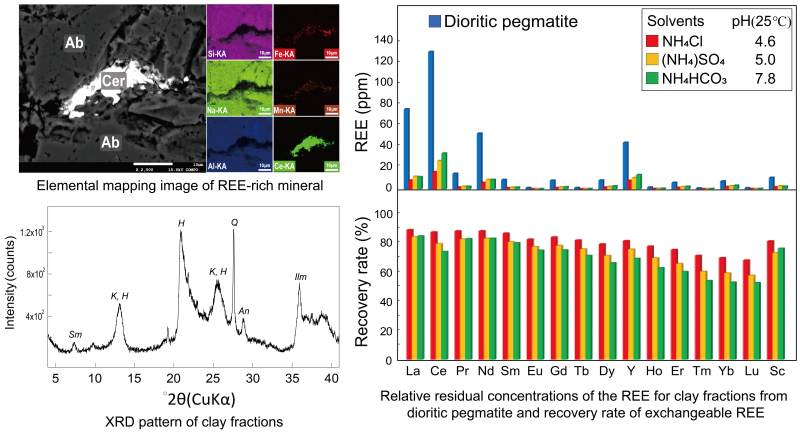
Geochemical characteristics of REE-enriched weathered anorthosite complex in Hadong district, South Korea
ABSTRACT

The mineralogy and geochemistry of the weathered intercumulate-type anorthosite complex in the Hadong district of South Korea were investigated as a prospective area for rare earth resource exploration. In this area, gabbroic anorthosite was intruded by rare-earth elements and yttrium (REE)-bearing dioritic pegmatites (av. 242 ppm), which caused REE-enriched Fe–Ti orebody accumulation (av. 857 ppm) near the dioritic pegmatites. REE-bearing minerals, such as allanite, cerite, and xenotime, were identified from the pegmatite and orebody, which had undergone various degrees of weathering. The total REE (∑REE) in kaolin minerals-bearing clay fractions increased compared to those of the whole rocks. When treated with ammonium-salt solvents of different pH values, that is, 4.6 (NH4Cl(aq)), 5.0 ((NH4)2SO4(aq)), and 7.8 (NH4CO3(aq)), 81%, 73%, and 70% of the exchangeable REE of the kaolin minerals-bearing clay fractions were recovered in the dioritic pegmatites. respectively. In contrast, in kaolin minerals-deficient clay fractions separated from the Fe–Ti ores, exchangeable REE were recovered less than 10% after treatment, regardless of the ammonium-salt solvent species. Therefore, the occurrence of REE-bearing primary minerals in the parent rock, the formation of kaolin minerals-bearing clay fractions, and the extraction rate of exchangeable REE with ammonium-salt solvents seem to be crucial to securing the ion-adsorption type REE resources.
KEYWORDS
weathered anorthosite complex, kaolin minerals, ammonium-salt solvents, exchangeable REE, Hadong district- Published : 2023
- Released on J-STAGE : 2023/02/09
- Received : 2022/08/02
- Accepted : 2022/12/17
- DOI : https://doi.org/10.2343/geochemj.GJ23002
- J-STAGE URL : https://www.jstage.jst.go.jp/article/geochemj/57/1/57_GJ23002/_article/-char/en
- J-Online ISSN: 1880-5973
- Print ISSN : 0016-7002
- ISSN-L : 0016-7002
All Issues
- Vol.59, 2025
- Vol.58, 2024
- Vol.57, 2023
- Vol.56, 2022
- Vol.55, 2021
- Vol.54, 2020
- Vol.53, 2019
- Vol.52, 2018
- Vol.51, 2017
- Vol.50, 2016
- Vol.49, 2015
- Vol.48, 2014
- Vol.47, 2013
- Vol.46, 2012
- Vol.45, 2011
- Vol.44, 2010
- Vol.43, 2009
- Vol.42, 2008
- Vol.41, 2007
- Vol.40, 2006
- Vol.39, 2005
- Vol.38, 2004
- Vol.37, 2003
- Vol.36, 2002
- Vol.35, 2001
- Vol.34, 2000
- Vol.33, 1999
- Vol.32, 1998
- Vol.31, 1997
- Vol.30, 1996
- Vol.29, 1995
- Vol.28, 1994
- Vol.27, 1993
- Vol.26, 1992
- Vol.25, 1991
- Vol.24, 1990
- Vol.23, 1989
- Vol.22, 1988
- Vol.21, 1987
- Vol.20, 1986
- Vol.19, 1985-1986
- Vol.18, 1984
- Vol.17, 1983
- Vol.16, 1982
- Vol.15, 1981
- Vol.14, 1980
- Vol.13, 1979
- Vol.12, 1978
- Vol.11, 1977
- Vol.10, 1976
- Vol.9, 1975
- Vol.8, 1974
- Vol.7, 1973
- Vol.6, 1972-1973
- Vol.5, 1971
- Vol.4, 1970-1971
- Vol.3, 1969-1970
- Vol.2, 1968
- Vol.1, 1966-1967




